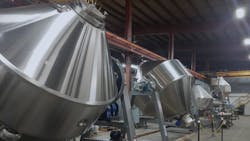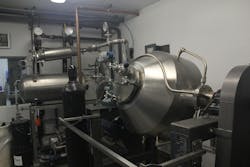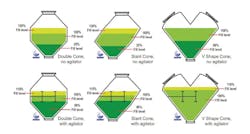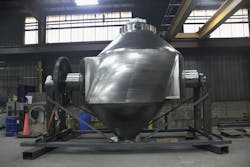Key Highlights
- Double cone and slant cone blenders provide gentle, consistent tumbling ideal for fragile powders.
- Fill level, blending time, and blender speed are critical for maintaining consistency across different blender sizes.
- Intensifier bars can enhance mixing, especially for de-lumping or dispersing additives but must be scaled carefully to preserve energy input per volume.
- Adjusting blender speed based on the material's angle of repose can help ensure proper cascading and uniform blending.

Scaling up or down a powder blending process can be a delicate balancing act, where one wrong move can turn a perfect mix in the lab into a costly, inconsistent mix at production scale. Whether moving a process from lab-scale development to commercial manufacturing or fine-tuning a process to accommodate smaller product volumes, success depends on understanding how blending dynamics change with size.
Choosing the right tumble blender design
Two of the most common tumble blender designs used across the pharmaceutical, metal additive manufacturing, and specialty chemical industries are double cone and slant cone blenders. These designs are known for their consistent, gentle tumbling action and reliable scale-up behavior. But even the most dependable systems can pose challenges if certain factors are not carefully managed.
When scaling up or down a powder blending process, understanding the science behind blending is essential. Both double cone and slant cone tumble blenders operate through gravity-based tumbling, where the material inside the blender is lifted as the vessel rotates and then cascades or rolls back down due to gravity. This creates a convective motion in which all particles move together in a repeatable pattern, promoting a homogeneous blend.
How blender geometry influences mixing performance
The shape of the blender plays a critical role in how effectively this tumbling mixes the particles. Double cone and slant cone designs provide a gentle blending action, ideal for fragile or friable materials, and their inclined geometry helps minimize “dead zones,” ensuring that every particle participates in the tumbling motion. V-blenders, on the other hand, enhance mixing by repeatedly splitting and recombining the batch, creating additional contact between particles.
To optimize efficiency, the blender geometry must be matched to the powder being processed (discussed later in this article). And when scaling a process, considering these factors helps ensure reproducible, uniform mixing while maintaining the integrity of the material.
Optimizing fill level for consistent blending results
When scaling a powder blending process, it is important to consider how much final product is to be output, as well as the necessary void space to maximize the effectiveness of the blend. For optimal performance, it is recommended to fill a double cone or slant cone blender to 40%-70% of the vessel’s total volume. Any more than that will significantly reduce the blending efficiency due to inadequate void space (non-working space) to promote gentle gravitational tumbling. The fill level may also vary depending on the addition of an agitator bar (discussed later in this article).
Maintaining blending time across different scales
A common industry rule of thumb for simple tumble blending is to keep the total number of vessel revolutions constant between scales. If the blend takes 150 revolutions in a pilot blender, it should take about 150 revolutions in the commercial-scale blender. Note that maintaining the same number of revolutions at a different scale may lead to a different overall blending time. For example, a blend time of 2 minutes in a 3-cubic-foot blender might scale up to 10 minutes in a 150-cubic-foot blender, reflecting an increase in time but still following a repeatable, proportional factor.
Controlling blender speed with the Froude number
The Froude number (Fr) is a critical dimensionless parameter used to ensure dynamic similarity (consistent forces) during scaleup. It represents the ratio of centrifugal force to gravitational force. The relationship is expressed as follows:
Fr = N2R/g
Where:
N = Rotation speed (typically in revolutions per second or RPM)
R = Vessel radius (or characteristic radius)
g = Gravitational acceleration
A constant Froude number is often used as a scale-up criterion. To keep (Fr) constant when scaling up to a larger radius (R), the rotational speed (N) must be reduced.
Using tip speed to balance shear and mixing efficiency
The tip speed (or vessel tangential speed) is the speed at which the outermost edge of the material in the vessel travels. Maintaining a constant tip speed (Vtip) is another common scale-up method, which helps ensure similar shear forces on the powder mass across different blender sizes.
Vtip ∝ ND
Where:
N = Rotation speed (typically in revolutions per second or RPM)
D = Vessel diameter
The optimal rotation speed for a cone blender is often reported to be 50%-80% of its critical rotational speed, which is the speed at which the centrifugal force on the powder particles matches the gravitational force. Beyond this speed, mixing efficiency decreases and the material may stick to the blender wall rather than exhibiting the desired cascading effect.
Preserving geometric similarity during scaleup
Maintaining geometric similarity when scaling up or down a blending process means keeping the ratio of all linear dimensions constant. This includes the fill ratio (batch volume/total blender volume), which should be the same in the large-scale unit as in the small-scale unit for maximum efficiency.
Enhancing blending with intensifier bars and agitators
Many cone blenders are equipped with internal intensifier bars (or agitators) to increase shear during tumbling. Intensifier bars are used for:
- De-lumping packed material
- Dispersing fine additives such as colorants or active pharmaceutical ingredients (APIs)
- Adding liquids
When scaling a process that uses an intensifier bar, the agitator run time and speed are typically scaled up proportionally with the main vessel blend time, but changes or adjustments may be needed due to differences in the agitator blade design between scales. Some trial and error is to be expected.
Also, special attention must be paid to ensure that the agitator’s energy input per unit mass (or volume) of powder remains consistent between scales.
Evaluating powder flowability with angle of repose
Powder flowability is a critical property in industries such as pharmaceuticals, food, and construction. Flowability is most accurately determined using a device such as the Jenike Shear Tester, but a quick and simple way to judge how easily a powder will flow in a tumble blender is to measure its angle of repose.
Angle of repose is simply the steepest angle formed by a loose pile of the material without material collapsing or sliding down. Imagine pouring sugar, flour, sand, or coffee grounds onto a horizontal flat surface. As the material falls, it naturally forms a cone-shaped pile. The angle of repose is the angle formed by the side of that pile and the horizontal surface. There are numerous resources for determining the angle of repose for almost any powder.
A low angle of repose (a flat, spread-out pile) indicates excellent flowability. The particles are likely smooth or round and not very cohesive, so they settle into a gentle slope. Dry sand is a good example.
Angles of 25° to 30° are considered excellent and frequently recommended to achieve success in tumble blenders.
A high angle of repose (a steep, pointy pile) indicates poor flowability. The particles may be rough, sticky, or irregular in shape, causing them to interlock and resist sliding, allowing them to stack up into a much steeper slope. Wet sand and flour are good examples.
Angles greater than 45° are typically considered poor and not desired in tumble blending processes.
Adjusting blender speed based on powder flow behavior
Adjusting the blender speed will affect the “powder body’s” angle of repose. Too little speed and the material may slip; too much speed and the material may not flow or cascade over itself, decreasing blending efficiency and powder dispersion.
Knowing the angle of repose for a specific powder and adjusting the blender speed in consideration of that angle is also critical to achieving repeatable consistent blends and scaling through a variety of equipment.
Best practices to avoid scale-up surprises
Scaling up a powder blending process is not just about using bigger equipment, it is about preserving the delicate balance of motion, energy, and flow that makes a blend uniform and consistent.
By understanding the tumble blender mechanics, maintaining geometric and dynamic similarity, and paying attention to material behavior, manufacturers can confidently scale up their powder blending processes without costly surprises.
About the Author

George Paffendorf
Vice president of operations at Advanced Powder Solutions
George Paffendorf is vice president of operations at Advanced Powder Solutions, which specializes in the development and optimization of powders across a range of industries, including pharmaceuticals, cosmetics, flavors & fragrances, nutraceuticals, additive manufacturing, plastics, food & beverage, and more.


